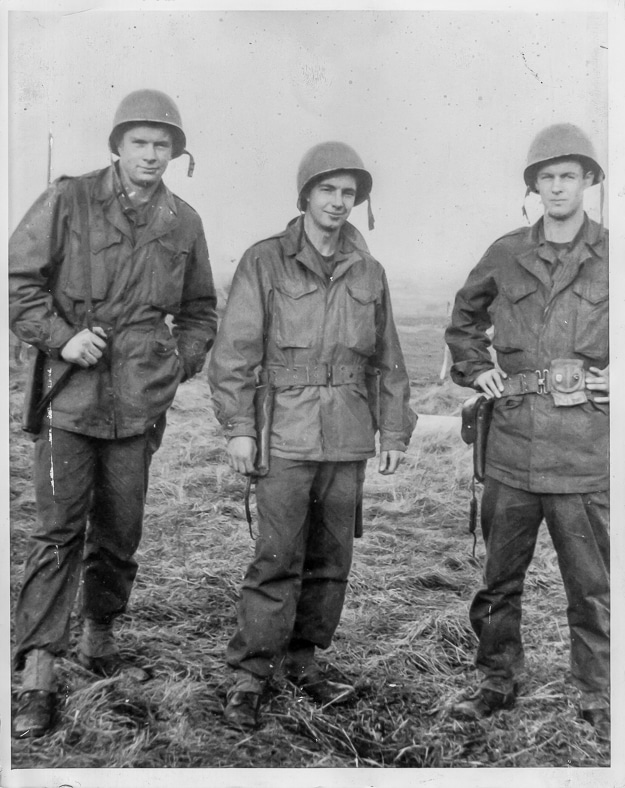
When I was very young, I first heard my father mention Bastogne. I had no idea what he was talking about, and had no idea what or where Bastogne was. It was only later, when I took an interest in the history of World War II, that I learned about it, and what it meant to have been there on Christmas 1944.
My father was a member of the 5th Ranger Battalion. As you might know, the Rangers and the Airborne were given all the hardest jobs that could be handled by small units. I once asked Dad why he’d volunteered for the Rangers, if he knew they would always be in the worst of it. “Well,” he said, “I figured the best way to avoid getting killed was to be the best soldier I could be, and have the other best soldiers around me.” If you read Steven Ambrose’s Band of Brothers about one company of the 101st Airborne, you’ll find that those soldiers expressed nearly the exact same sentiments.
According to records I found of the 5th Rangers, they’d been attached to an armored division headed for Bastogne and were serving, more or less, as a vanguard that would make first contact with the enemy and then call up the big guns. Dad never went into too much detail of how this led his squad to actually reach Bastogne just in time to get surrounded there with the 101st. When I asked him how he got separated from the main force, he just said, “As usual, we were lost.”
Some posts on Travel Past 50 may contain affiliate links. If you buy something through one of those links, we may earn a small commission. As an Amazon associate, we earn from qualifying purchases.

Again, because he was a real combat soldier, for much of his life he didn’t offer any detail of what Bastogne, or any other battle, had been like. The only tale of Bastogne I did hear was when I got to tag along when he went to a memorial service in 2006 for one of the men in his squad. I got to have lunch with Dad and his best friend from his unit, Zel Rice. They both told the story of when they were in the woods outside Bastogne being shelled by the Germans. He and Zel both jumped for the hole when the shelling started. One shell hit very close and the concussion knocked Dad’s helmet flying, right into Zel’s face. Both of them were knocked silly by the blast and it took them a minute to recover. When they did, Zel told me he said to Dad, “Shit, Bartel, I thought that was your fucking head.”
Dad said he figured out at Bastogne the two things that every soldier should know in order to stay alive: Never share a foxhole with someone who is braver than you are; and Try to look unimportant, the Germans might be low on ammunition.
Gallows humor.
It would be hard to improve on the tiny bits of information of what it was like to be at Bastogne during the Battle of the Bulge that I got from Dad and Zel, but the people who live in Bastogne now have done an admirable job with the new Bastogne War Museum.
The basic supposition of the museum, and the right one I think, is to try to explain the Battle of the Bulge to people who had no direct contact with people who were there. They do this in a few ways that work very well.
First, of course, are the didactic displays at the beginning that offer a basic course in the lead up to the war itself and then moves quickly on to the German invasion and occupation of Western Europe from 1940-1944. The narrative is enlivened with cinema news from the era, as well as everyday and military objects that give the visitor a good idea of what life was like for Belgians of the time. The third phase, and the primary focus of the museum, is the period from December 1944 to the end of the war in Europe five months later. This time is when Belgium, and particularly the area around Bastogne, suffered the most. To enliven the static displays of the war material, you also get two interactive scenes: one of the forest outside the city where the American soldiers took a terrific pounding; and the other of a tavern in the city where the locals took refuge during the bombardment.
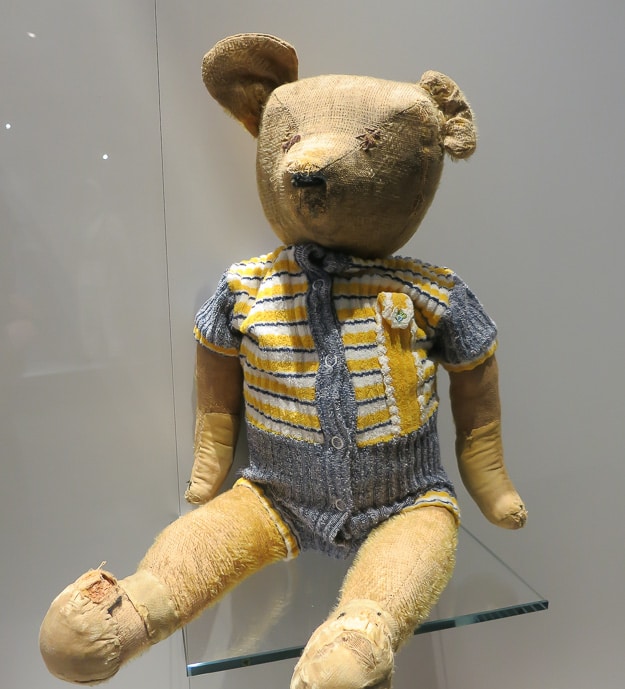
These scenes are narrated by four “characters” who lead you through the various exhibits. Through these characters, you get to hear descriptions of the battle from the perspective of an American soldier, a German soldier, a 13-year-old boy from Bastogne, and his school teacher–all of whom are just trying to survive. These civilian characters reminded me that my Dad once said that he always felt so sorry for the civilians. “They were always caught between us and the Germans, and they had it tougher than we did.”
Along with these narratives are carefully placed video screens which show interviews with eyewitnesses to the battle of Bastogne. Particularly poignant was the testimony of a Belgian man who described how some of his friends from a neighboring town had been shot by the Germans for collaborating with the Americans.
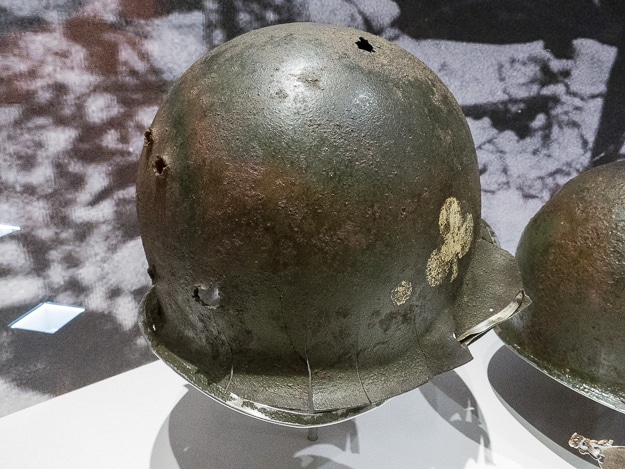
The combination of the elements make for innovative way to guide you through a museum, and along with the excellent collection of artifacts, both civilian and military, you get a visceral sense of what it must have been like to be there. Two I recall particularly were a Sherman tank with two German shell holes, and a pile of American helmets, just like the one my dad wore, that had been shredded by bullets and artillery shrapnel.
My father’s not around to tell his stories any more. It’s a true service that there are museums like the Bastogne War Museum to keep those stories alive. Maybe hearing them enough will help stop the next war.
P.S. I want to give special thanks to Mathieu Billa of the Museum staff for guiding us through the exhibits, and more important, marking for us on a map the forest where Easy Company of the 101st Airborne (and probably the lost squad of the 5th Rangers) were pinned down. We drove out of Bastogne to that bit of wooded area, and also to the German war cemetery just down the hill. Wandering those very quiet sites were even more emotional than the Museum.
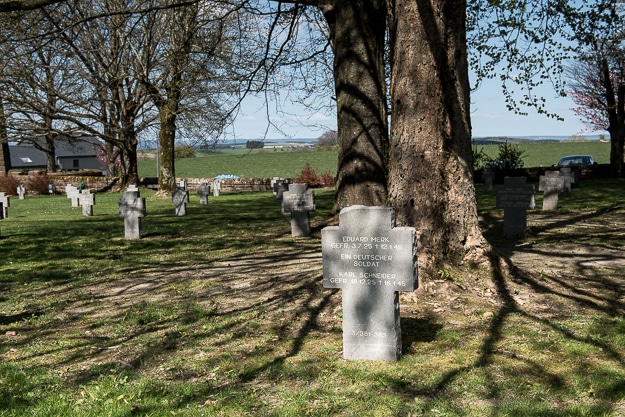

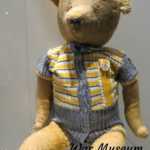
That is one of our favorites museums anywhere. I truly felt the history come alive. It didn’t hurt, of course, that we were traveling with a group of WWII veterans, three of whom were there and one who served under Patton. Their stories made the history relevant and they opened up with stories even their wives of 50 years had never heard. A truly remarkable group of men.
Yes, my dad only opened up very rarely, and I heard more when we had lunch with his partner Rice than I did in the 50 previous years. It was all new to my mother, as well. A few times after the war, my mother traveled to Europe with my father’s sister, but he never wanted to go. Too many memories, I think, that he didn’t want to recall. They finally did visit the Omaha Beach cemeteries, where Dad also fought. Mom told me he completely broke down.
It’s still hard to believe what your father and the citizens of Europe went through (did to each other) only 10 years before I was born.
It certainly is, Suzanne. I like that the cultural guardians are going out of their way to make these new exhibits, even as all the people who experienced WWII first hand are dying off. It’s important that these stories aren’t lost.
Their experiences created the appropriate record and they started out with experiences even their spouses of 50 years had never observed. A truly amazing group of men. Thanks for sharing.
True Sally, for the most part, my father never even talked about his experiences to my mother. She maybe heard more about them from me than from him.
Thanks for this thoughtful piece, Tom. Jon’s dad was in WWII also; he died before I met Jon (but Jon does have a few of the mementos and occasionally shares the stories). Love the photos with this piece, too.
Thanks, Jeannie. Too many of these vets have passed without recording their stories. It’s a shame so many are lost.
The stories that always affected me–the squad captured a German soldier and it turned out he was just a smooth-cheeked kid, thirteen or so. They pinned a note on him saying,”Americans don’t kill children” and sent him back to his line.
When Buzz was shot, his thigh shattered, his buddy Zel Rice stopped to drag an old mattress out of a shell of house, shoved Buzz on it to keep him out of the mud, and kept going on to fight.
Sounds like something he’d do. As for Rice and the others, you just know that all of them would have done anything for each other.
Thanks for this, Tom. Your father was a very brave man.
Actually, to hear him tell it, he wasn’t. He just said he was usually too scared to do anything other than what he did. Of course, I’ve read his Silver and Bronze Star citations, and I agree with you.
Tom, We’ve been to Bastogne and many of the other war memorials a few times, but we plan on going back for the anniversary. I just read Kristin’s post and it doesn’t sound like you will be in Belgium for Memorial Day. If you are, at all the American cemetaries they plant flags and have a ceremony. My daughters have volunteered for them, and even laid wreaths, when they were Girl Scouts. I just thought I would mention this, because you might be interested.
Corinne, we’ve now visited the Ardennes and the Normandy Cemeteries. The way those memorials are kept up and honored is truly impressive. When the attendants learned that Kris’s uncle was buried at Ardennes, they were so kind to us. They walked us out to his grave and stood there with us while we just sort of gaped. It was heartfelt and a lovely moment, thanks to the attendant. I’m sure the Memorial Day ceremonies must be something, but I’m not sure I could take the emotion.
Sometimes I think my generation and the generation that is following me are incredibly out of touch with the realities of the past and how the wars of yesteryear are still being fought today in many parts of the world just with different faces doing the fighting.
I’m currently reading ‘The Victors’ by Stephan E. Ambrose and there has been more than one occasion where I’ve been watery eyed to read the experiences of men who would have been five and up to ten years younger than I am now. It’s just incredible to think of the sacrifices made and I’m so glad that there are places still being opened today like the Bastogne War Museum.
Thanks so much for sharing your father’s story.
Dale, I’m sorry I missed your comment last year. Ambrose does a great job of conveying what it was like for those young men. My father was 21 when he landed on Omaha Beach and not quite 22 when his legs were shattered in Colmar, France–the wounds that ended the war for him. When I was that age, I was enjoying goofing off in college that my father was paying for.
My dad, Louis Sorace, was a member of the Battling Bastards of Belgium. I never had the privilege of meeting him as he died there. I wonder if there is anyone out there who knew him or of him and would be kind enough to share. always wonder how life would have turned out if he had come home, but sadly I will never know.
After all these years I still feel the loss.
Lois, I was one of the lucky ones to get just a few snatches of the story out of my dad. Unfortunately, the last of his squad mates died last year before I had the opportunity to quiz him some more. Nearly all of the men of that time are gone now. My father would have been 92 this year.
Is Vincent Speranza Still alive ?
Betty, I don’t know about whether he’s still alive, but i do love his story. As for the major who threatened to shoot him at the aid station, my father told me another story of a major at an aid station who accosted Dad’s squad mate Dave Richter because Richter, who was reporting to the aid station with a wound to his arm, didn’t salute him. Dad said Richter thought about pulling his .45 with his good arm and shooting the major, but changed his mind. Wonder if it was the same major.
My grandfather called it “the battling bastards of Bastogne”.
Is this thread still active?
Janet, any thread is still active that is being read and getting comments. Do you have a question?